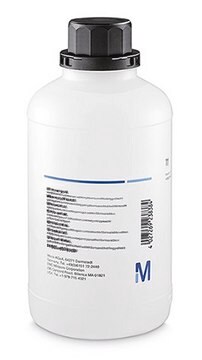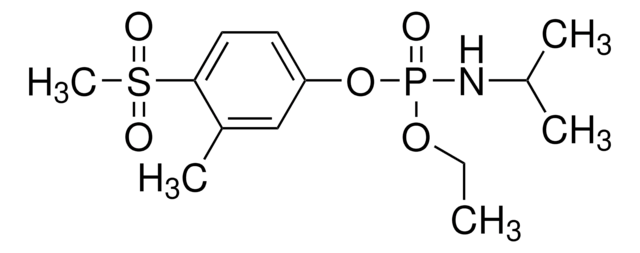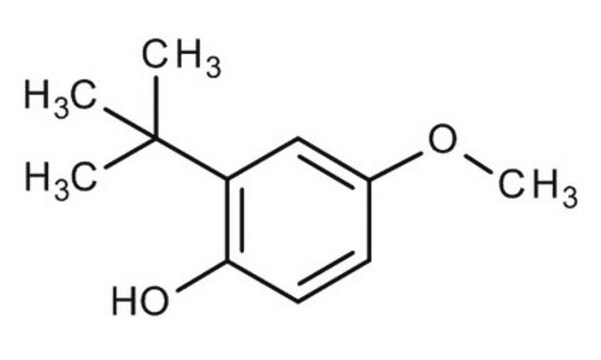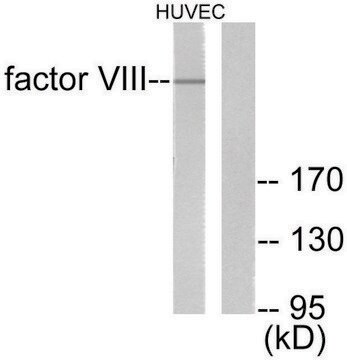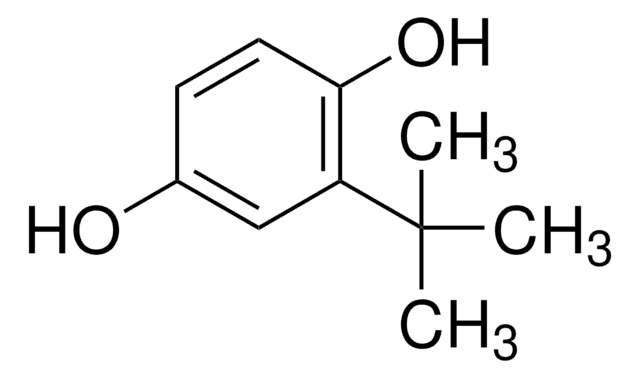Wichtige Dokumente
W218308
Butyliertes Hydroxyanisol
99%, FCC, FG
Synonym(e):
2(3)-t-Butyl-4-hydroxyanisol, 2(3)-t-Butylhydrochinon-monomethylether, BHA
About This Item
Empfohlene Produkte
Biologische Quelle
synthetic
Qualitätsniveau
Qualität
FG
Fragrance grade
Halal
Kosher
Agentur
follows IFRA guidelines
Einhaltung gesetzlicher Vorschriften
EU Regulation 1223/2009
EU Regulation 1333/2008 & 178/2002
FCC
FDA 21 CFR 117
FDA 21 CFR 172.515
Dampfdichte
6.2 (vs air)
Assay
99%
Selbstzündungstemp.
599 °F
mp (Schmelzpunkt)
58-60 °C (lit.)
Anwendung(en)
flavors and fragrances
Dokumentation
see Safety & Documentation for available documents
Nahrungsmittelallergen
no known allergens
Allergener Duftstoff
no known allergens
Organoleptisch
mild
SMILES String
O(C)c1cc(c(cc1)O)C(C)(C)C
InChI
1S/C11H16O2/c1-11(2,3)9-7-8(13-4)5-6-10(9)12/h5-7,12H,1-4H3
InChIKey
MRBKEAMVRSLQPH-UHFFFAOYSA-N
Suchen Sie nach ähnlichen Produkten? Aufrufen Leitfaden zum Produktvergleich
Verwandte Kategorien
Allgemeine Beschreibung
Anwendung
- Inhibition of NADPH oxidase 2 enhances resistance to viral neuroinflammation by facilitating M1-polarization of macrophages at the extraneural tissues.: This study examines the potential neuroprotective effects of butylated hydroxyanisole (BHA) in modulating immune responses during viral infections of the nervous system, suggesting BHA′s utility in reducing neuroinflammation through macrophage modulation (Choi et al., 2024).
- Highly Sensitive Electrochemical Determination of Butylated Hydroxyanisole in Food Samples Using Electrochemical-Pretreated Three-Dimensional Graphene Electrode Modified with Silica Nanochannel Film.: This study presents a novel method for detecting BHA in food products, emphasizing its role in food safety and quality control, and showcasing advanced material use for enhanced analytical performance (Huang et al., 2024).
- Purification and identification of novel antioxidant peptides derived from Bombyx mori pupae hydrolysates.: While focusing on antioxidant peptides, this research also contextualizes the antioxidant market where BHA is prominently used, underscoring the ongoing search for natural and effective alternatives in food and pharmaceutical industries (Chukiatsiri et al., 2024).
H-Sätze
P-Sätze
Gefahreneinstufungen
Aquatic Chronic 2
Lagerklassenschlüssel
11 - Combustible Solids
WGK
WGK 2
Flammpunkt (°F)
241.9 °F - Pensky-Martens closed cup
Flammpunkt (°C)
116.6 °C - Pensky-Martens closed cup
Persönliche Schutzausrüstung
Eyeshields, Gloves, type P3 (EN 143) respirator cartridges
Hier finden Sie alle aktuellen Versionen:
Besitzen Sie dieses Produkt bereits?
In der Dokumentenbibliothek finden Sie die Dokumentation zu den Produkten, die Sie kürzlich erworben haben.
Kunden haben sich ebenfalls angesehen
Unser Team von Wissenschaftlern verfügt über Erfahrung in allen Forschungsbereichen einschließlich Life Science, Materialwissenschaften, chemischer Synthese, Chromatographie, Analytik und vielen mehr..
Setzen Sie sich mit dem technischen Dienst in Verbindung.

